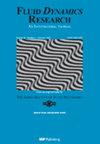New single vortex generation method for flame/vortex interaction using flow behind a rotating cylinder
IF 1.3
4区 工程技术
Q3 MECHANICS
引用次数: 0
Abstract
This paper investigates a new experimental method to generate a single two-dimensional translated vortex for flame/vortex interaction studies. A rotating cylinder is immersed in a uniform flow and, its rotating speed is impulsively reduced. This sudden action triggers the generation of a single vortex when both the initial and the final rotation speeds are in the range of a steady-state regime. Flow visualization allows confirming the applicability of this method, while a complementary two-dimensional numerical simulation is conducted to understand the vortex formation process. A vorticity layer is detached from the cylinder, initiating a feeding process and gradual growth of a single leading vortex. The feeding process is saturated at a specific distance from the cylinder and, vortex separation from the vorticity layer is observed. At the final stage of the formation process, the generated vortex is advected away and, a steady-state regime is again established behind the cylinder. The vortex characteristics appear to be related to the normalized reduction in the rotation rate ∆α, defined as the initial and final rotation rates difference normalized by the initial rotation rate. Several combinations of initial and final rotation rates corresponding to different normalized reductions are investigated experimentally and numerically. The results allow understanding the effect of this parameter; a higher normalized reduction generates a stronger, more rapidly growing vortex. However, its trajectory is related to the wake deviation corresponding to the final rotation rate.利用旋转圆柱体后的流动产生火焰/涡流相互作用的新的单涡生成方法
本文研究了一种用于火焰/涡流相互作用研究的生成单个二维平移涡流的新实验方法。旋转的圆柱体被浸没在均匀的流动中,其旋转速度被脉冲降低。当初始转速和最终转速都在稳态范围内时,这种突然的动作触发了单个涡流的产生。流动可视化可以确认该方法的适用性,同时进行补充的二维数值模拟以了解涡流的形成过程。一个涡度层从圆柱体上分离,开始了一个馈送过程,并逐渐形成一个单一的前导涡。进给过程在离圆柱体特定距离处饱和,并观察到涡旋与涡度层的分离。在形成过程的最后阶段,产生的涡流被平流带走,并在圆柱体后面再次建立稳态状态。涡流特性似乎与转速∆α的归一化降低有关,∆α定义为通过初始转速归一化的初始和最终转速差。实验和数值研究了与不同归一化折减相对应的初始和最终转速的几种组合。结果使我们能够理解这个参数的影响;标准化程度越高,产生的涡流越强、增长越快。然而,它的轨迹与对应于最终转速的尾流偏差有关。
本文章由计算机程序翻译,如有差异,请以英文原文为准。
求助全文
约1分钟内获得全文
求助全文
来源期刊

Fluid Dynamics Research
物理-力学
CiteScore
2.90
自引率
6.70%
发文量
37
审稿时长
5 months
期刊介绍:
Fluid Dynamics Research publishes original and creative works in all fields of fluid dynamics. The scope includes theoretical, numerical and experimental studies that contribute to the fundamental understanding and/or application of fluid phenomena.
 求助内容:
求助内容: 应助结果提醒方式:
应助结果提醒方式:


